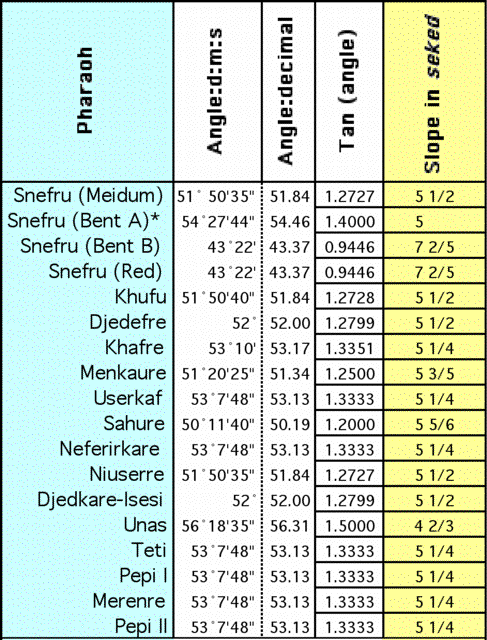When you first see the pyramids, especially at Giza, you get the impression that they all have the same slope angle. Closer examination and careful measurement show that each pyramid has a unique slope angle, and this is true for all of the 4th and 5th Dynasty pyramids.

The graph shows the principal pyramids of the 4th to 6th dynasties, i.e. the Old Kingdom pyramids, excluding Djoser's Stepped Pyramid and those that were not completed. The slope angle in degrees for each pharaoh's pyramid is shown on the y-axis. Against each plot, a ratio is shown. This ratio shows the way in which the ancient Egyptians might have described slopes - as proportions of vertical to horizontal. Angles in degrees are a recent invention; for most of history, builders and architects used proportions to control building shapes, slopes etc.
The proportions relate to angles as follows. Take Khufu's Great Pyramid with a ratio of 7:51/2, or 14:11, vertical: horizontal. If we take the inverse tangent of 14/11, we get 51.84 degrees, or 51 degrees 50 minutes and 34 seconds. That's 6 seconds off from the usually-quoted figure of 51 degrees, 50 minutes and 40 seconds. Pretty close.Try it for yourself, using a calculator with tangents, or tables if you prefer.
Note that the slopes gradually evolve towards a ratio of 4:3, in the 6th Dynasty at the right. Note also the tendency to use two successive integers to define the slope: 17:18, 5:4, 4:3, 3:2. Where the designers deviated from whole numbers, they used unitary fractions, i.e. fractions with a '1' in the numerator: 1/2, 1/4, 1/8.
The Rhind Papyrus shows that the ancient Egyptians measured slopes in units called the seked.

The table shows each pyramid slope measured in seked, at right. Khufu's Great Pyramid has a slope of 5 1/2 seked. This is derived from the proportions as follows. Divide the horizontal by the vertical (11 / 14) and multiply by 7 - result, 5 1/2 for Khufu, and the same method works for all pyramid slopes. An alternative (modern) method is: slope in seked = 7 x cotangent(slope angle).
Note again that, with rare exceptions, the ancient Egyptians used unitary fractions when setting up slopes using seked.
Note, too, the conspicuous absence of 45 degrees, or a slope of 1:1. This smacks of a symmetry taboo, or of perfect symmetry being reserved for something special.
So, did the architects use proportions or seked? Well, they certainly used seked in documents, so they probably used them to specify pyramid slopes. But architects, even today, like to think in terms of proportions, e.g. "that looks just a bit too wide for its height." So, it is reasonable to suppose that they used proportions when thinking and talking to each other, but seked when they needed to commit to papyrus.